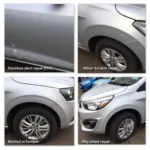Car body repair hints can save you time, money, and frustration, whether you’re dealing with a minor scratch or more significant damage. Knowing a few key tips can make all the difference in achieving a professional-looking repair and preserving your car’s value. From assessing the damage to selecting the right tools and techniques, we’ll cover everything you need to know to tackle car body repair with confidence.
Understanding the Basics of Car Body Repair
Before diving into specific car body repair hints, it’s crucial to understand the different types of damage and the appropriate repair methods. Minor scratches and scuffs often only require touch-up paint and some polishing. Deeper dents and scratches may necessitate the use of body filler and sanding. For more extensive damage, such as a cracked bumper or dented panel, replacement or professional repair might be the best option. Accurately assessing the damage is the first step towards a successful repair. Are you dealing with a surface scratch or something that requires more attention? Knowing the answer will guide your repair strategy.
Choosing the right tools is equally important. From sanding blocks and body filler spreaders to paint spray guns and polishing pads, having the correct equipment will ensure a smooth and efficient repair process. Don’t underestimate the importance of proper preparation. Cleaning the damaged area thoroughly and masking off surrounding areas will prevent further damage and ensure a clean finish.
DIY Car Body Repair Hints: Addressing Minor Damage
For minor scratches and chips, a DIY approach can be both cost-effective and satisfying. Start by cleaning the affected area with soap and water, then dry it thoroughly. Apply touch-up paint carefully, matching the color as closely as possible. Allow the paint to dry completely before using a polishing compound to blend the repair seamlessly with the surrounding paintwork. Remember, patience is key when working with touch-up paint. Multiple thin coats are preferable to one thick coat, which can lead to unevenness and dripping.
What if you’re dealing with a small dent? Paintless dent repair (PDR) can be a great option for minor dents that haven’t damaged the paint. This technique involves using specialized tools to massage the dent out from the inside of the panel, restoring its original shape without the need for filling or repainting.
When to Seek Professional Help
While some car body repair hints empower you to handle minor issues yourself, there are times when professional help is necessary. Extensive damage, such as structural damage or damage to critical components, should always be addressed by a qualified technician. Attempting to repair such damage yourself can compromise the safety and structural integrity of your vehicle. Additionally, complex paint jobs, particularly those involving multiple colors or intricate designs, are best left to the experts. A professional car body repair shop has the expertise, equipment, and experience to deliver a flawless finish.
Don’t hesitate to seek professional advice if you’re unsure about the extent of the damage or the best course of action. A reputable car body repair shop can provide a thorough assessment and recommend the most appropriate repair solution.
Preventing Future Damage: Proactive Car Body Repair Hints
Protecting your car’s bodywork is an ongoing process. Regularly washing and waxing your car can help prevent scratches and fading caused by environmental factors. Using a car cover can shield your vehicle from the elements, especially if you park outdoors frequently. Parking strategically can also minimize the risk of dings and dents. Choosing well-lit areas and avoiding parking too close to other vehicles can make a significant difference.
Conclusion: Mastering Car Body Repair
Car body repair hints can empower you to address minor damage and maintain your car’s appearance. From understanding the basics of damage assessment to knowing when to seek professional help, these tips will help you navigate the world of car body repair with confidence. Remember, preventative measures are just as important as knowing how to repair existing damage. By following these car body repair hints, you can keep your car looking its best for years to come.
FAQ
- What is the best way to remove small scratches from my car? Touch-up paint and polishing compound can often effectively address minor scratches.
- Can I repair a dented bumper myself? Depending on the severity of the dent, you might be able to repair it using body filler and sanding.
- How do I choose the right touch-up paint for my car? Check your car’s owner’s manual or look for a paint code sticker on your vehicle to find the exact color match.
- What is paintless dent repair (PDR)? PDR is a technique for removing minor dents without the need for filling or repainting.
- When should I seek professional help for car body repair? For extensive damage, structural issues, or complex paint jobs, it’s best to consult a professional.
- How can I prevent car body damage? Regular washing, waxing, and using a car cover can help protect your car’s finish.
- What should I do if I’m unsure about the best way to repair car body damage? Consult a reputable car body repair shop for expert advice.
Need assistance with car body repair moulded like blue tack? Read more about it here: car body repair moulded like blue tack.
Need more information? Check out our article on car body damage here. For further assistance, contact us via WhatsApp: +1(641)206-8880, Email: [email protected]. We have a 24/7 customer support team ready to help.


